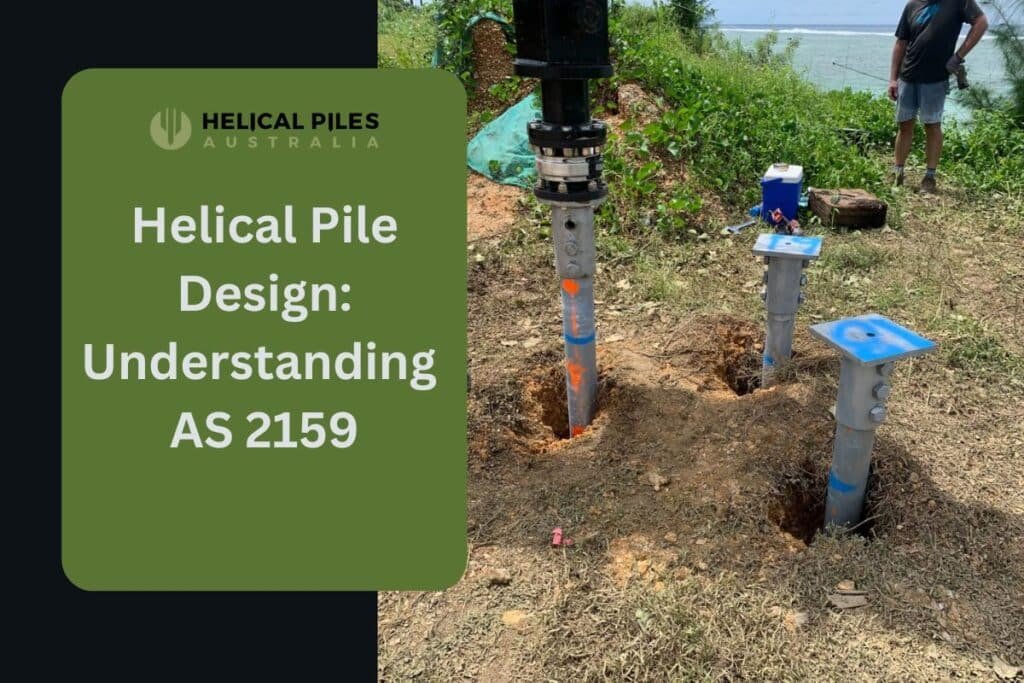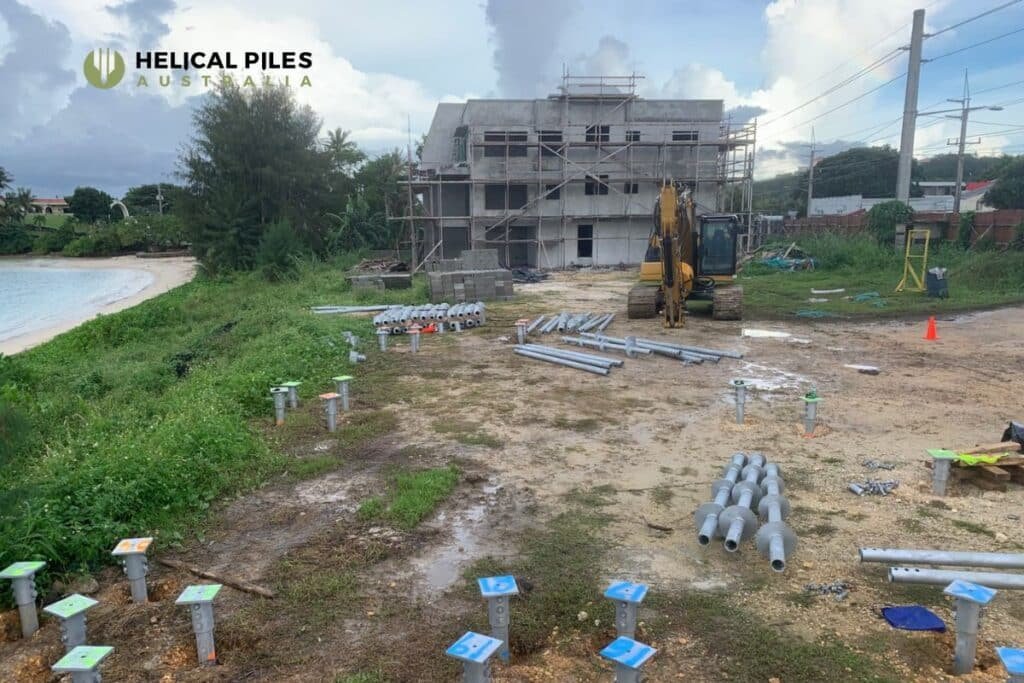ARTICLE
Helical Pile Design: Understanding AS 2159

Helical piles are a trusted deep foundation solution for many Australian construction projects. This guide breaks down the essential requirements of AS 2159, the Australian standard for piling design and installation. We will cover everything from site investigation and capacity calculations to installation best practices. Following this guide ensures engineers and builders can achieve full compliance and project success.
What Are Helical Piles and Why Are They Popular in Australia?
Helical piles, often called screw piles, are a type of deep foundation. They consist of a central steel shaft with one or more helix-shaped plates welded to it. These piles are screwed deep into the earth to transfer the weight of a structure to more stable, load-bearing soil.
Their design makes them incredibly versatile for varied Australian ground conditions. Whether dealing with the reactive clays common in Melbourne and Adelaide or the sandy soils of coastal regions, helical piles provide a reliable solution. Their popularity comes from key benefits like rapid installation, minimal site disturbance, and the ability to be loaded immediately after installation.
The Role of AS 2159 in Australian Piling Projects
The standard AS 2159-2009, Piling – Design and Installation, is the core document governing all piling work in Australia. This includes the design and installation of helical piles. This standard provides a framework to ensure safety, quality, and performance for all foundation projects.
Following AS 2159 is not just a recommendation; it is a mandatory requirement under the Building Code of Australia. Adherence to the standard protects builders, engineers, and property owners by guaranteeing that the foundation is designed and constructed to withstand its intended loads for its entire service life.

Key Stages of Helical Pile Design According to AS 2159
The helical pile design process is a systematic journey guided by the strict requirements of AS 2159. It begins with understanding the ground and ends with a fully specified and engineered foundation plan. Each stage is essential for a safe and effective outcome.
Stage 1: Geotechnical Investigation and Site Assessment
The first and most important step in any piling design is a thorough site assessment. AS 2159 mandates a comprehensive geotechnical investigation to understand the subsurface conditions. This is typically presented in a detailed geotechnical report.
This report identifies the different soil layers, their strength, the depth to bedrock, and the presence of groundwater. This data is the foundation of the helical pile design, directly influencing the required pile depth, diameter, and helix configuration needed to support the structure safely. Without this information, any design is simply guesswork.
Stage 2: Determining Pile Capacity and Load Requirements
Once the ground conditions are known, engineers calculate the required load-bearing capacity of the helical piles. This involves assessing both axial loads, which are compression and tension forces, and lateral loads from factors like wind or soil pressure.
AS 2159 outlines two main methods for calculating the pile’s ultimate strength. The first is a theoretical calculation based on the soil properties found in the geotechnical report. The second is an empirical method using torque correlation, which relates the energy required to install the pile to the soil’s load-bearing capacity. Engineers apply strict safety factors to these calculations to determine the final, safe design load.
Stage 3: Structural Design and Material Specifications
This stage focuses on the physical integrity of the pile itself. The steel pile must be strong enough to resist the structural loads from the building and the pressures exerted by the ground during and after installation.
AS 2159 provides specifications for the steel materials, including the minimum thickness for the shaft and helix plates, as well as standards for welding quality. The design must account for forces that could cause buckling, bending, or shearing of the pile. The engineer selects the appropriate pile components to ensure the pile remains structurally sound throughout its design life.
Corrosion Protection for Longevity in Australian Conditions
Steel foundations are susceptible to corrosion, and AS 2159 places a strong emphasis on durability. The standard requires an assessment of the soil’s aggressiveness to determine the necessary level of corrosion protection. This ensures the foundation will last for its intended service life, which can be 50 years or more.
For most Australian conditions, hot-dip galvanizing provides excellent corrosion protection for helical piles. In more aggressive environments, such as coastal areas with high salinity, additional measures may be required. These can include using thicker steel, applying specialised coatings, or installing a cathodic protection system with sacrificial anodes.
The Helical Pile Installation Process and Quality Control
A great design is only effective if it is installed correctly. The installation phase is where the engineered plan becomes a physical reality. Quality control on-site is essential to verify that the piles perform as designed.
Installation Torque and Its Importance
During installation, the amount of rotational force, or torque, needed to screw the pile into the ground is continuously monitored. This installation torque is a direct, real-time indicator of the soil’s density and strength. It is a critical piece of data for quality assurance.
Specialised hydraulic drive heads equipped with torque-monitoring devices are used for this process. The final installation torque for each pile is recorded and compared to the target torque specified in the helical pile design. This torque correlation method provides immediate confirmation that the pile has reached the required depth in a competent soil layer and has achieved its design capacity.
On-Site Pile Load Testing
For major projects or when conditions are uncertain, AS 2159 provides for physical pile load testing. This is the most definitive way to verify a pile’s capacity. It involves applying a test load to an installed pile to measure its performance under pressure.
This process provides absolute proof of capacity and confirms the design assumptions.
- Step 1: The test pile is installed to the specified depth and target torque.
- Step 2: A reaction frame and a calibrated hydraulic jack are positioned over the pile.
- Step 3: A load is applied to the pile in slow, controlled increments, often up to twice the design load.
- Step 4: The pile’s movement or settlement is measured with high-precision instruments at each load step.
- Step 5: The resulting data is analysed by an engineer to confirm the pile’s performance meets the project’s requirements.
Common Applications for Helical Piles in Australia
The versatility of helical piles makes them suitable for a vast range of projects across Australia. Their efficiency and low impact are valued in many sectors.
In residential construction, they are ideal for new home foundations, especially on sites with reactive soils or sloping blocks.
They are also widely used for underpinning and foundation repair, stabilising existing homes that have experienced settlement. For commercial buildings, helical piles provide a rapid and reliable foundation for warehouses, retail centres, and office buildings. They are also used extensively in infrastructure projects, supporting everything from solar farms and bridges to communication towers and boardwalks in sensitive coastal areas.
Summary On Helical Pile Design (AS 2159)
Designing helical piles in Australia is a precise engineering process governed by the AS 2159 standard. This guide has shown that the process logically moves from a detailed geotechnical investigation to careful design and verified installation.
By following these principles, you ensure that your foundation is safe, compliant, and built for decades of performance. Using certified professionals who understand these standards is the best way to leverage the full benefits of helical pile technology. For expert advice and services tailored to your project, our engineering team is here to help.
Frequently Asked Questions About Helical Pile Design (AS 2159)
What Is the Australian Standard for Piling?
The main Australian standard for piling is AS 2159-2009, Piling – Design and Installation. This document covers all types of foundation piles used in Australia, including helical piles. It sets the rules for geotechnical investigation, design, installation, and testing to ensure safety and reliability.
How Do You Design a Helical Pile?
The design of a helical pile is a multi-stage process defined by AS 2159. It starts with a geotechnical investigation to understand the soil. Engineers then calculate the load capacity needed, considering both the soil’s strength and the pile’s structural limits. The final design specifies the pile’s dimensions and the required installation torque to guarantee performance.
What Is the Capacity of a Helical Pile?
The capacity of a helical pile varies for each project and depends on the specific ground conditions and the pile’s dimensions. In Australia, capacities can range from a few tonnes for a deck footing to over 100 tonnes for a large commercial structure. An engineer determines the final design capacity through calculations that are verified during installation by monitoring the torque correlation.
What Are the Disadvantages of Helical Piles?
While highly effective, helical piles are not suitable for all sites. They can be difficult to install in ground with large boulders, dense cobbles, or very shallow rock, as these obstructions can prevent the pile from advancing. Their capacity can also be limited in extremely soft or organic soils like peat, and their upfront material cost can be higher than concrete, though installation savings often balance this out.
How Are Screw Piles Designed in Australia?
In Australia, screw piles are designed using the exact same principles as helical piles, as the terms are interchangeable. The process must strictly follow AS 2159-2009. This involves a site investigation, engineering calculations for geotechnical and structural capacities, and applying safety factors to ensure a robust and compliant foundation design.
What Is the Difference Between a Helical Pile and a Screw Pile?
In the Australian construction industry, there is no functional difference between a helical pile and a screw pile. Both terms refer to a steel foundation pile with helical plates that is screwed into the ground. “Screw pile” is the more common term used on-site in Australia, but “helical pile” is also widely recognised and used in engineering specifications.
Need a quote or more info? Start here.
Contact Us
info@helicalpilesaustralia.com.au
+61 2 7251 9258
Mon–Fri, 8:00am–5:00pm AEST

Built for complexity.
Engineered for certainty.
A trusted partner for large-scale energy and infrastructure projects where precision isn’t optional, it’s mandatory
© 2025 Helical Piles Australia. All rights reserved.
Privacy Policy
Contact Us
info@helicalpilesaustralia.com.au
+61 2 7251 9258
Mon – Fri, 8:00am – 5:00pm AEST
Location
Ground Floor 3, 189 Kent St
Sydney, NSW 2000

